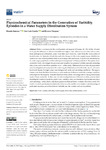Mostrar o rexistro simple do ítem
Physicochemical parameters in the generation of turbidity episodes in a water supply distribution system
| dc.contributor.author | Juncosa, Ricardo | |
| dc.contributor.author | Cereijo Arango, José Luis | |
| dc.contributor.author | Vázquez, Ricardo | |
| dc.date.accessioned | 2023-05-25T16:09:39Z | |
| dc.date.available | 2023-05-25T16:09:39Z | |
| dc.date.issued | 2022 | |
| dc.identifier.citation | Juncosa, Ricardo, José Luis Cereijo, and Ricardo Vázquez. 2022. "Physicochemical Parameters in the Generation of Turbidity Episodes in a Water Supply Distribution System" Water 14, no. 21: 3383. https://doi.org/10.3390/w14213383 | es_ES |
| dc.identifier.uri | http://hdl.handle.net/2183/33132 | |
| dc.description | This research was funded by EMALCSA. Agreement between EMALCSA and the University of Coruña (FUAC). Project INV01819/2019-2022. | es_ES |
| dc.description.abstract | [Abstract:] Water is necessary for the development and support of human life. The ability of water to supply the different populations has different origins: water taken from river diversions, water from underground catchments, water from lakes and reservoirs, water from the recirculation of treated water, etc. Episodes of turbidity and color changes in the water supply in pipe distribution systems are non-isolated problems that occur in many cities and towns. In particular, sedimentation in water supply pipelines and the subsequent resuspension of these particles in the system have created the need to investigate the processes and variables that promote turbidity episodes, including why, when, and where these episodes occur. In this study, different physicochemical parameters were investigated and analyzed in the water supply distribution network of the city of La Coruña (northwest Spain) through a pipe monitoring panel under real operating conditions. The supply waters come from the Mero river basin, a basin made up of siliceous materials, a unique condition with respect to the majority of studies that have been carried out using waters coming from basins made of basic materials. In this case, the relationships between different variables were studied, including the number of particles, particle size, turbidity, color, concentration of particulate materials, and mineralogy. In this article, only those parameters that are better correlated have been noted. The results revealed a predominant relationship between color and the concentration and mineralogy of particulate materials, as well as between turbidity and the number and size of particles. | es_ES |
| dc.language.iso | eng | es_ES |
| dc.publisher | MDPI | es_ES |
| dc.relation.uri | https://doi.org/10.3390/w14213383 | es_ES |
| dc.rights | Atribución 3.0 España | es_ES |
| dc.rights.uri | http://creativecommons.org/licenses/by/3.0/es/ | * |
| dc.subject | Water quality | es_ES |
| dc.subject | Turbidity | es_ES |
| dc.subject | Water supply networks | es_ES |
| dc.subject | Sedimentation | es_ES |
| dc.subject | Color | es_ES |
| dc.title | Physicochemical parameters in the generation of turbidity episodes in a water supply distribution system | es_ES |
| dc.type | info:eu-repo/semantics/article | es_ES |
| dc.rights.access | info:eu-repo/semantics/openAccess | es_ES |
| UDC.journalTitle | Water | es_ES |
| UDC.volume | 14 | es_ES |
| UDC.issue | 21 | es_ES |
| UDC.startPage | 3383 | es_ES |
| dc.identifier.doi | 10.3390/w14213383 |






